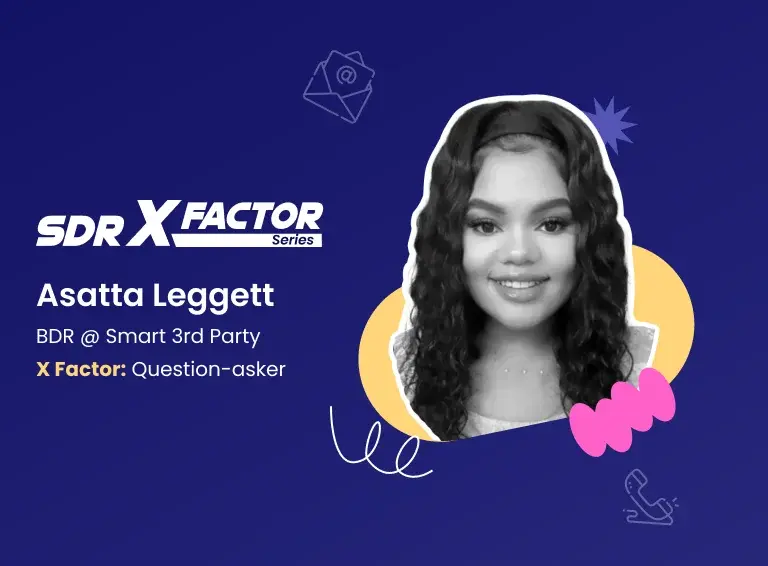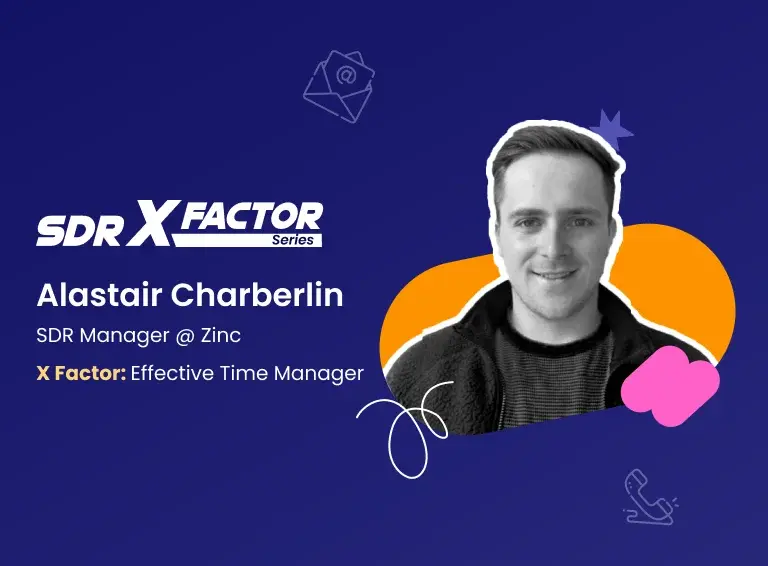Whether it’s playing field hockey or closing deals at Pleo as a Mid-market AE, Jan Benedikt Mundorf loves a challenge.
This drive to come out on the other side of challenges is what makes him an exceptional salesperson. A regular quota-exceeder, he hit a whopping 143% of his monthly quota in March 2023. In 2022, he closed 43 deals in total, and Pleo awarded him the Ambassador of the Year.
With over 12,000 followers on LinkedIn, Demandbase named Jan as one of the top 25 AEs to follow on LinkedIn in 2022 for posting useful sales content.
In this third chapter of the Closers X Factor series, we reveal his selling processes and negotiation tactics and all the behind-the-scenes activities that help him win big deals and crush quota.
1) This Is How Jan Organizes the Crap Out of His Day
Wondering how successful sales account executives organize their days and create timeblocks? Well, Jan’s got you covered.
Typically, he starts his day at 8.30 am in his office, and leaves work at 6.30 pm. Here’s a day in his life:
- 8.30 am to 9 am: Goes through the day’s agenda, finishes any pending tasks from the day before, and morning discussion with colleagues.
- 9 am to 10 am: Prepares for his demos and discovery calls. He gets a basic understanding of the accounts based on inputs from SDRs and his own research.
- 10 am to 12 pm: First block of demo calls.
- 12 pm to 12.45 pm: Lunch break. After lunch, he takes a short walk to refresh himself for the rest of the day.
- 1 pm to 2 pm: Call block, where he calls his existing prospects.
- 2 pm to 4 pm: Second block of demo calls.
- 4 pm to 5 pm: Follow-up slot, where he catches up on previous conversations. If needed, he records videos explaining a specific use case to nurture the account.
- 5 pm to 6 pm: Admin time. Being the final timeblock of his day, he updates his CRM by logging his tasks and other information. He also reflects on what went well that day and plans the tasks for the next day.
- 6.30 pm: Out of office.
2) Minimum Time, Maximum Research
When it comes to research, Jan tries to get the maximum amount of value in the minimum possible duration.
As he sits down to prepare for his calls in his first timeblock, he applies the 5x5 approach, made popular by sales leader Kyle Coleman.
He sets a timer for 5 minutes, and he gets 5 facts about an account. The facts include:
- Headcount growth
- Tool stack
- Job advertisements
- Prospect’s background (How long they’ve been with the company, recent promotions etc)
- Company’s mission
"5 minutes, 5 things, and then you're good to go. You’ll always be able to have a good conversation around that, and it's very structured."
3) Getting the Hard Facts Out in a Discovery Call
Jan usually has at least one discovery call scheduled every day. In a good week, he has 6 discovery calls. He follows the MEDDIC lead qualification framework for discovery.
In each of these calls that lasts 15-30 minutes, he looks to extract what he terms as “hard facts.” These help him to understand and quantify their pain points, which helps him in planning his demo.
Some of the questions he asks during discovery call:
- What made you take this call today?
- Why do you feel the need to change your existing solution?
- What are the costs of not doing anything?
- Why is this important to you?
- What is your evaluation process like?
- What does your decision making process look like from here?
"Discovery will make or break a deal. Here, you can really set the tone for the conversation."
4) Why Agenda Setting Helps in Laying Out the Next Steps
Before asking the questions, Jan usually lays down the agenda by summarizing how each of the processes—discovery, demo, and negotiation—will look like.
Why does this matter? It builds anticipation in the minds of the prospect, making them eager to continue talking to the AE.
Also, as they have an idea of what’s coming up next, they’d be more forthcoming to fix the next call or reply to emails, and are less likely to go cold after the first call.
5) Make Rapport Building a Rewarding Experience—Literally
Jan’s rapport building skills are so good, that prospects don’t just stop with becoming customers.
They mail him gifts like sweaters and handwritten letters afterwards.
How does he build such good rapport with prospects during the discovery call? By making each prospect feel unique.
From his research, he finds one professional thing about the prospect—like a promotion or career switch—that he can bring up during the conversation to say, “I’m curious to learn about this from you.”
This achieves 2 things:
- Since he’s asking about the prospects, they open up almost immediately.
- He stands out from other AEs, who usually ask about things like the weather or the weekend.
"Find something that makes you really interested in them, and be curious. If you treat everybody the same, they will realize. You need to treat them case by case, and make them feel unique as well."
6) Jan’s Battle-Tested Formula To Nail Sales Demos
Here’s the simple but effective formula that Jan uses to make his demos successful:
- Show only those features that are relevant to the prospect.
- Articulate the product value by explaining what these features mean to them.
- Ask a gap question: “Compared to what you're having right now, how would this feature help you better in your day-to-day decisions?”
Before showing the product, he asks the prospect to list the top 3 decision criteria. During the demo, he’ll hark back to these 3 criteria and how his solution could satisfy these.
He typically brings up pricing toward the end of the demo. Sometimes, he’ll talk about pricing earlier in the call as some prospects bring it up first.
As his demos could last anywhere from 30 minutes to an hour, he stops sharing his screen every now and then to answer questions from prospects. This helps in sustaining their interest through the course of the call.
"I tell them, ‘Listen, this is not a demo. This is a conversation where I work on things that are important to you. You need to tell me if I'm talking too slow or too fast. And I want to show you the things that are only relevant to you.’ They usually value that."
7) Negotiate Like a Pro With the Quid Pro Quo Mindset
The key to navigating negotiation for Jan is having a give-and-take mindset.
Or a quid pro quo mindset, because Latin phrases are fancy.
For example, if the prospect asks for a particular discount, he’d say that they will get the discount only if they give a certain number of referrals for the product.
This makes negotiation a win-win situation for both parties.
Also, he carries out his negotiation over video calls and not over emails. It’s quicker to understand the context of the prospect’s ask in a call, which makes the negotiation process smoother. If the prospect is hesitant to set up a call, he sees it as a red flag that the deal is going sideways.
"In general, negotiation happens along the entire discussion. It's always a give and take. You give me the information so that I can show you the product, and you give me the input so that I can give you the price."
8) Adding a Dash of Urgency To Nudge Deals to the Finish Line
Urgency is the catalyst that converts the deals caught up in the negotiation stage.
Throughout the negotiation process, Jan puts the spotlight on the prospect to create urgency in their minds and get them to sign the contracts. He pulls this off by doing these 2 things:
- He first highlights the goals that they revealed during the discovery and demo calls and explains how his solution will help them achieve those. He terms this as the “If you want to never do this again, this is what you need to do” approach.
- Next, he presents the usual activities in the negotiation phase, like setting up calls to discuss the ROI, negotiating the contract, and verification, as a set of tasks that he and the prospect shall do together to ultimately achieve their goals.
"That's the difference between an average sales rep, and then the top AEs, because they come across as trusted advisors, who help solve the customer’s project."
9) What Does It Take To Be an Agile AE?
An agile salesperson goes where the prospects are in the buyer’s journey.
The buyer behavior of today is markedly different than what it was, as many buyers prefer researching independently before entering the sales funnel.
So, to be an agile AE, Jan adapts his selling based on how educated the prospect is about the product. He gauges this during the discovery phase.
If they’re using a competitor already, he cuts the discovery short and jumps into the demos as early as possible. Here, the aim is to show how his solution is different and can solve their pain points better.
On the other end, where the prospect doesn’t have a solution in place and doesn't know much about the solution, he’d extend the discovery process a little more than usual.
"We really are in an age where buyers are super educated. You need to be flexible, because buyers have done their research. If they come to you, they’ve done three parts of the buying journey already. And then you need to educate them."
10) How to Close Deals During an Economic Downturn?
The economy has slowed down worldwide, and a recession is impending.
In this down economy, Jan focuses all through his sales process on how his solution can help prospects reduce their costs. Whether it's discovery, demo, or negotiation, the product narrative will be around security, control, and cost savings.
"In the end, you need to be able to sell to the CFO. The CFO will make the decision, and they are interested in cost savings, and cost control."
11) On the Side
Do You Have a Morning Routine Before Coming To Work?
“I take a walk, meditate, eat something nice, listen to good music, and bicycle to work. I try to be in a positive and optimistic mindset when I come to work.”
One Thing You Won’t Compromise When It Comes to Work-Life Balance?
“I'm in a rowing club, so I do rowing 4 times a week. This is non-negotiable.”
Who Do You Follow on LinkedIn for Sales Insights?
Kyle Coleman, Nick Cegelski and Armand Farrokh, Chris Orlob, and Mattia Schaper.
What Is the Best Sales Advice You’ve Ever Received?
“The world still goes on, whether you close the deal or not. So, don’t take rejection personally and just move on.”
That’s a wrap on the third episode of The Closers X Factor series, where we uncover the processes that help top-performing AEs close deals every time. We'll be putting out a story of one outstanding AE every week, which you can read here. The series is written by me, Akileish R, and edited by Ashitha Jayaprakash.
Also, if you’re in the mood to learn how top sales reps can break quota records, here’s the previous season—The SDR X Factor series—featuring 8 quota-smashing SDRs from companies like G2, Metadata, Zinc, and more. See you real soon!





